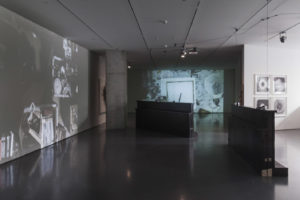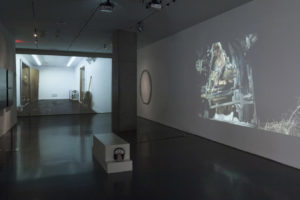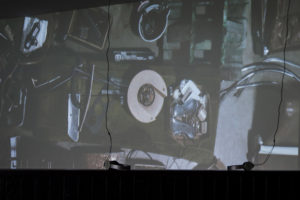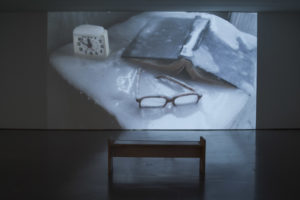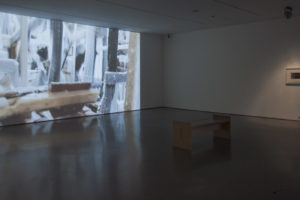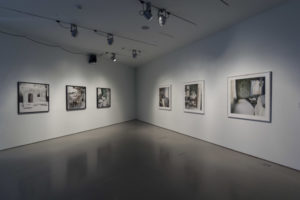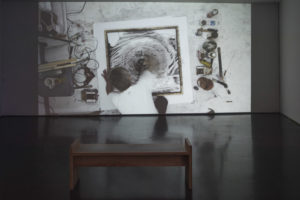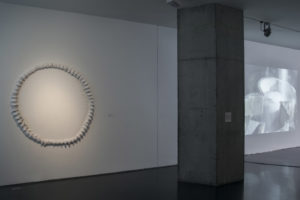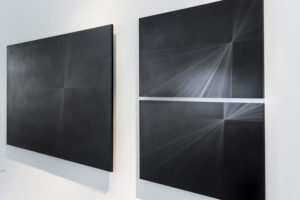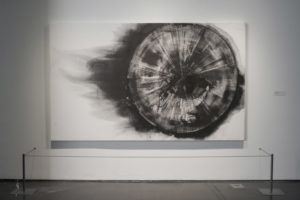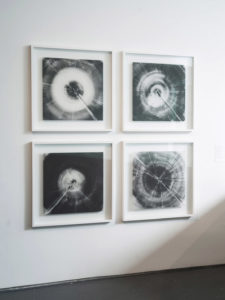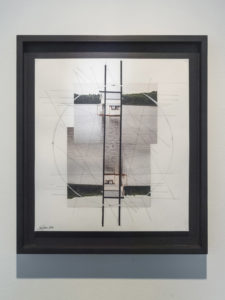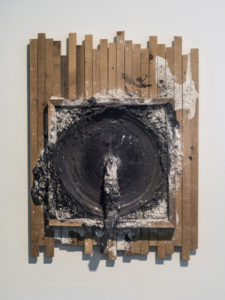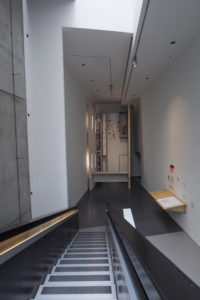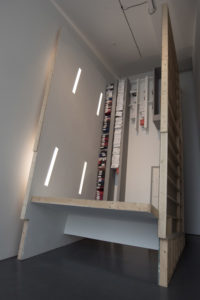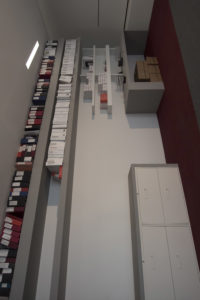Installation Photos Courtesy of Tony Walsh/The Contemporary Arts Center, Cincinnati
Function is Redundant
What if we treated the heavy, physical realities of labor, building and the structures we live with the same disbelief that we apply to movies, myths and dreams? Speaking to a rustic species of cinematic surrealism that renders the environments he builds just believable enough for the viewer to enter, artist Chris Larson muses, “In the frame of the camera, the world makes sense.” Employing said lens to organize the hypnotic worlds he makes feel astonishingly ordinary, Larson constructs humble hallucinations whose mutual lack of function and feasibility somehow makes sense when performed within his viewfinder. As a self-declared “sculptor” of the uncanny videos that have become the signature vessel of his artistic voice, he practices a form of “rogue architecture” and homegrown alchemy that recasts buildings and their inhabitants in an illuminating stupor. Like bewitching folk tales that are paradoxically stranger the “realer” they appear, Larson sources many of his ideas in a semi-lucid state, “when,” in his words, “my brain is unhinged, anything seems possible, and ideas are unedited.” For him surrealism is not about what is unreal, but rather about what is “most real.” Expanding this consideration to the psycho-geography of his upbringing, we can also trace many of Larson’s folkloric imaginings to his early life in rural Minnesota – where abandoned shacks, obsolete farm machinery and pioneering labor collectively established a vernacular that continues to reverberate through his work. In this light, old shacks and contraptions took on oracle-like qualities – transcending their original intent and industrialization to float as amorphous agents with open application. Finding energy in objects that are “raw and imperfect,” he very purposefully builds in wood (with few, if any, preparatory drawings) and with a minimum of electric power – eschewing precision and polish to cobble arcane machines that are all too human in their imperfections. These structures are subsequently propelled by either the artist or a cast of anonymous protagonists, further amplifying the human engine of his work and its delivery via labor, toil and the camera’s conspiratorial gaze. Whether transmitted by photo or video, the ensuing episodes are more dream than documentary, employing the veracity we traditionally entrust to lens-based media to add gravitas to his mind- (and body-) bending environments. Much like how writer Tom Wilkinson describes Alfred Hitchcock’s ability to “[put] the viewer deep in the picture,” Larson presses us close up to the screen, arranging rooms for our visual entry, and implicitly leading our eye through his unfolding labyrinths as he travels with us; camera in tow; climax on the horizon.
In Larson’s vision of radical ruralism, where elemental forces often pierce the airless arenas of modernism and domesticity, many of his actions culminate in, or collect within, collisions, destruction and/or incineration. Indicting finished products as “inert, tedious to the eye,” and “dead,” he turns instead to demolition to unlock the nascent energy and “potential” of both objects and effigies. In so doing, Larson takes what writer Michael Tortorello calls “an apocalyptic view toward architecture,” which has involved burning, shooting, drenching and dropping cars and aircraft through brutalized buildings. And yet, he is careful not to couch his use of a controlled burn as iconoclasm or disrespect, but rather as an “act of hope” that evokes bonfires of old, the changing of seasons, and cycles of life and death. Such ruinous beauty, catharsis and spectacle informed a cedar facsimile of the Branch Davidian complex he built in 2011, and a measured assault upon the International Style of modernist architecture in the aptly titled 2013 work Celebration/Love/Loss. For the latter, Larson recreated an obscure 1962 house designed by the famously austere architect Marcel Breuer and set it aflame during a public event – paradoxically commemorating the 50th anniversary of a structure he admires with a pyre that brought newfound attention to an otherwise static abode. By inscribing new histories and actions into an enduring, but ossifying edifice, the smoldering site became a palimpsest rather than a void, and “a way,” in Larson’s words, “to begin anew.” The blackened remains of punk musician/drummer Grant Hart’s childhood home receive a more tranquil, but equally reverent treatment in the 2016 video Land Speed Record, where Larson slowly surveys antiques, auto parts, instruments and other items retrieved from a 2011 house fire. And while the work is titled after a live album by Hart’s Minnesota punk band Hüsker Dü, the cacophony of his breakneck drumming stands in stark contrast to the camera’s meditative inventory that gently congregates a portrait of Hart, as well as a moment in music history. Considering both these works in concert, we see how explicit material damage prompts a corresponding shift in one’s psychological architecture – where embers spark the onset of renewed appraisals.
Such movement parallels Larson’s ongoing practice of re-locating public and private architectural spaces to push otherwise fixed and familiar locations into evolving frontiers. For a 2015 commission from the Katonah Museum of Art, he recreated the modernist home of the Museum’s architect Edward Larrabee Barnes (1915-2004) such that the block-like house looked to be dragged on logs, elevated on timber cribbing and pierced in multiple locations by spruce trees. Larson did so as a response to Katonah’s astounding 1897 tale of relocation when, facing displacement due to the government-imposed construction of a reservoir, the townspeople lifted and relocated their homes using logs pulled by horses along soap-slicked timbers. Over a century later, the successors of these trees perforate an effigy of Barnes’ pristine geometry with a cathartic violence that showcases Larson’s revelatory amalgams – complicating our desire for order and insulation with the untamed improvisations of nature. Conflation by way of collision is the primordial, if more episodic, “big bang” that steers this work: intertwining binaries of city and country; culture and nature; as well as cinema, performance and sound. As a dedicated guitarist with a copious record collection, Larson regularly employs music to propel the metamorphosis. Channeling both Huck Finn and the Mississippi River that neighbors his St. Paul studio, Larson partnered with long-time artist and friend Rico Gatson in 2014 to perform The Raft, a multi-faceted installation where an overhead camera follows the pair on a slow moving platform as they mash-up music from their respective histories. This glacial drift into a charged, but layered fracas succeeds the seminal 2007 project Crush Collison where Larson enlisted the aforementioned Hart, performance artist Britta Hallin, percussionist Michael Bland, and gospel quartet The Knight Family in a dual narrative taking place on a floating house. Arranged once again for the camera and its insatiable appetite for theatre, the title of this work comes from ragtime composer Scott Joplin’s song about a staged 1896 publicity event in the short-lived town of Crush, Texas where a pair of 32-ton locomotives were crashed into one another – head-on at 120mph – in front of a fervent crowd of 50,000 people. Larson’s homage is decidedly less bombastic, while still celebrating the illuminating discord that underpins integration, of both people and places. In a two-story house with a pair of interwoven plots, we first observe Hart and Hallin as they toil with an archaic machine creating a circular loop of clay, beaten and smoothed ad infinitum. This endless labor transports Hart’s mind to a more ascendant, if no less resolved scene where he rocks a silver piano back and forth while, on another floor, an African-American family sings an impassioned spiritual about suffering, salvation, and heavenly release. No ends or answers are secured here, but passage takes on a curiously seductive aura.
Larson’s implicit manifesto of fluidity, motion, fruitful ruination and an exercise of labor that exceeds utility is nurtured and amplified in the white cube in which he spends the most time – his studio. As a mirror of the artist’s mental architecture and the romanticized incubator in which ideas take flight, the studio has long been a muse to modern and contemporary artists such as Bruce Nauman and Dieter Roth. Larson participates in this discourse while simultaneously deconstructing its sanctity, in a series of works collected under the banner of Studio Unhinged, where the very notion of a “home base” is rendered fundamentally contingent. Multiple streams of his practice converge in the 2015 video Heavy Rotation, where the term for a frequently played song is applied to a serial perforation that marries the spinning vinyl of The Raft with the epiphany-inducing loop of Crush Collision. At this intersection we observe Larson as he transforms the studio itself into an evolving sculpture – building a turntable apparatus to rapidly wheel ink around a page that, like the work as a whole, regularly overflows its surrounding frame. From the elevated perspective of a video camera he suspends above said station, Larson subtly, but skillfully, marries both horizontal and vertical orientation to create a surreal, Escher-like convergence where he appears to be working on both wall and floor at once. As Larson occupies this liminal space and spins the arm ever faster, the trance inducing motion is jarringly disrupted as he pierces a surface that is both picture plane and the ground upon which we gaze. When Larson peers through the ensuing void he recasts the typical reading of the artist’s studio as a surrogate self-portrait – evoking Rene Magritte’s paradoxical 1937 portrait of Edward James (Not to be Reproduced) where the back of the subject’s head replaces his anticipated reflection in the facing mirror. As Larson subsequently lowers a ladder through the circular excision and travels down his homemade rabbit hole, he orchestrates a chorus of additional mirroring effects – building the same frame and cutting the same hole in what looks like the same studio. After another passage into a third space that resembles the former pair, Larson amplifies the feedback loop as he exits stage right and rotates the entire structure from just off-camera. As all the contents of the room subsequently slide from one side to the other – much like our attempts to attach logic or apprehension to these peripatetic targets – professor Wayne Roosa aptly notes how “interiors and exteriors are conflated as we shift between physical realities and psychological constructs.” Compasses spin and maps flounder in this mesmerizing arena, pushing our cerebral cartography into a fluid place much like the pencils in Larson’s sister work Reservoir Drawing, floating up and down the walls of an undulating antechamber. From inside these immersive parallaxes both inhabitant and environment are mutually unmoored, navigating embryonic spaces where the performance of place becomes an end unto itself.
Akin to the legendary Winchester House and its aim to confound its haunted guests via labyrinthine structures, Larson’s surreal architectures compel us to stay a while, and turn the act of inhabitation into surreal dramaturgy. In 2015 he collaborated with composer Anthony Gatto to bring the darkly humorous world of author Flannery O’Connor’s Wise Blood to an old factory-turned-gallery, translating distorted architectural follies into the stage and subjects of an opera/exhibition hybrid. The ensuing experience blurred the lines between performer and passenger, conjuring a shared realm of skewed perspectives, uncertain footing and heightened awareness. O’Connor was a Southern Gothic writer traversing the many stigmas of the “Deep South,” and Larson’s admiration of her writing was heightened all the more by O’Connor scholar Ralph Woods and his corresponding vision of the “Deep North”– where deviance accrues in frigid temperatures, rural terrain and paranoiac isolation. In both the physical and conceptual vein of Crush Collison, Larson once engineered a tableau where a life-sized model of the General Lee car crashes dramatically into the Unabomber’s Montana cabin in a flourish of the outsider neurosis that supposedly collects in the margins, north and south. A hypothetical manifestation of the thinking that underpins such “madness” followed in 2008, where Larson recreated a fully furnished Louisiana-style shotgun shack in the frigid hinterlands of Minnesota and covered everything in “thick, unrelenting ice.” The only things that moves in this Deep North is a triad of mysterious, methodical protagonists clad in felt uniforms as they transport tubes of ice from the front of the house to the back via a massive machine. This device was born from Larson’s interest in a “force” that could move unimpeded through the structure while still shaping its constitution; in his words, “I wanted to install a machine inside as though it had grown up out of the house.” Like an unwieldy relic of the Middle Ages meets Rube Goldberg, this colossal contraption is one of many in Larson’s work where function becomes a secondary concern in rhapsodic exercises of uncertain purpose. That which operates in Deep North arguably produces more problems and questions than it provides answers or service, and that ambiguity is exactly the intention. These clumsy, lumbering technologies are very clearly not about streamlining or efficiency, but rather a slow, meditative, seemingly monotonous labor in which reason withers and rhythm is born.
Somewhere between valiant dedication and absurd repetition, the ceaseless exertions within Larson’s work eschew linear production and mindless mechanization to inhabit a threshold where metaphors and contemplation fill the cracks of fractured utility. In these meetings of man and machine, whether that be in architecture, instruments, vehicles and/or the studio, the actions that Larson organizes are not cynical diatribes about dystopian toil, but rather about labor that is exploratory, synaesthetic and transformative. Inspired by the uncanny manner in which Franz Kafka made the banal feel preternatural, and how so many of his characters were developed “not by who they are, but what they do,” Larson adds, “I have never been interested in the final product. I am interested in the emotions and questions that are created by the physical interaction with the machine and the materials.” With arms, legs, mouth and head Larson’s litany of machines are resolutely powered by people rather than electricity, forging an evocative symbiosis that re-humanizes operations we have increasingly delegated to the apparatus. Each ensuing activity and structure weaves repetition and redundancy into its DNA, cultivating circles, mirrors and loops that – much like saying the same word over and over again – de-familiarizes the seemingly ubiquitous. His recent series of Threshold Drawings are a microcosm of this quiet metamorphosis, turning four quadrants and a dense overlap of lines into a torqued burst, a quickening. In so doing, Larson eschews escapism and otherworldly fantasy in favor of the strangeness inherent in reality, and the ways in which the mind takes flight via actions that are “minimal and mundane.” Within cycles that speak to perpetuity rather than parameters, he explains, “My works begin in the middle of an action and end in the middle of an action. Nothing is ever resolved.” Meaning is found here in the posing of questions rather than the pursuit of their answers, in the impact of collisions rather than their aftermath, and in labor that replaces production, function and closure with another rotation, and another.
– Steven Matijcio, 2018
